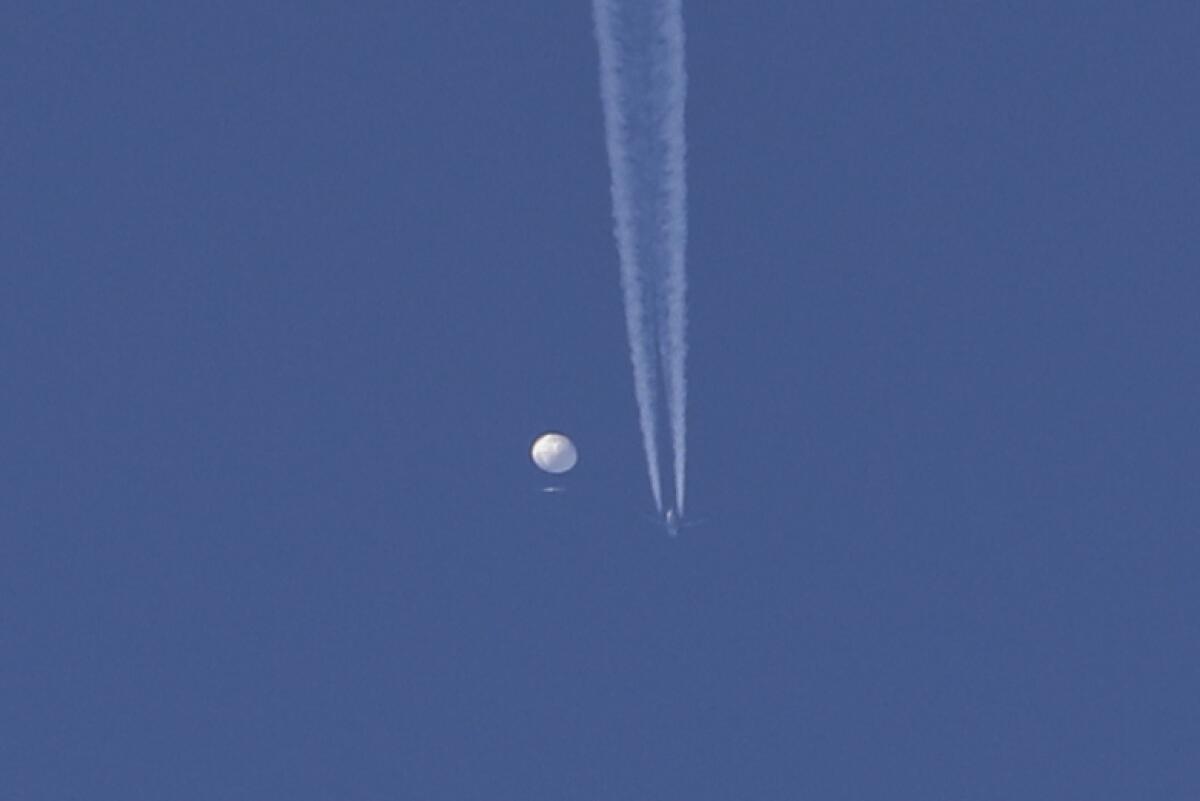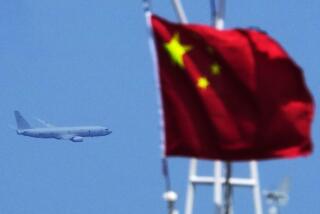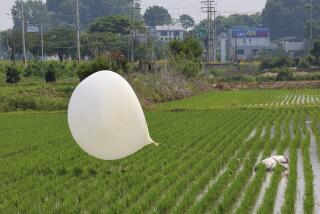U.S. downs Chinese balloon over ocean, moves to recover debris

- Share via
WASHINGTON — In a sharp but unusual escalation in tensions between Washington and Beijing, the United States on Saturday shot down what it described as a Chinese spy balloon that in the last 96 hours swept across U.S. airspace, covering thousands of miles and flying over sensitive military installations.
American fighter jets were scrambled out of Langley Air Force Base to attack the massive balloon off the coast of Myrtle Beach, S.C., Defense Secretary Lloyd J. Austin III announced. An F-22 jet fired a single missile into the craft, causing it to crash. With the jet’s puffy white trails streaking the baby-blue sky, the balloon became misshapen and then dropped into the sea from about 65,000 feet of altitude.
Operations to recover debris from the balloon and its enormous payload were launched immediately by a contingent of Navy and Coast Guard vessels, which, along with the Federal Aviation Administration, blocked off sea and air access and grounded civilian flights. The balloon went down over U.S. waters, Austin said, within roughly 12 to 14 miles off the coast and before a sharp drop-off in the seabed.
Pentagon officials said they could not tell how long the recovery will take — the debris field extends some seven miles — but they were relieved that most of the fallen material rests primarily in about 47 feet of water.
“They successfully took it down and I want to compliment our aviators that did it,” President Biden said after the shoot-down was confirmed as he arrived at Hagerstown Regional Airport in Maryland.
Biden told reporters he ordered the military to down the aircraft on Wednesday, but accepted recommendations from Austin and others to wait until there was minimum chance for damage to people or property on the ground.
The administration has been criticized in some quarters, especially among China hawks in Congress, for not shooting the balloon down sooner. It entered Alaskan airspace on Jan. 28, crossed into Canada on Monday and then headed south toward Idaho and beyond starting Tuesday, according to a timeline provided by senior Pentagon officials.
As the U.S. expands military operations in Australia’s Darwin Port, both countries are uneasy over the fact that a Chinese company controls it.
China has maintained that the balloon was a research vessel being used for meteorological investigation and that it accidentally drifted into U.S. airspace.
Pentagon officials, who dismissed that explanation, said they expect to examine the debris to learn how and what the balloon’s instruments were surveilling, and to better understand Chinese technology in use.
They said they were confident they had limited the balloon’s ability to collect intelligence and, at the same time, turn scrutiny back on the Chinese asset.
“This actually provided us a number of days to analyze this balloon and through a number of [classified] means ... learn a lot about what the balloon was doing, how it was doing it, why the [People’s Republic of China] might be using balloons like this,” said a senior Defense official who briefed reporters on condition of anonymity.
The balloon episode was not the first time China has used aerial technology to spy on the U.S. while intruding its airspace, the official said. But never has the intrusion lasted this long, he added. And drones, not balloons, have been the preferred instrument of espionage.
While the long-term impact of the incident is not yet clear, it has further inflamed tensions between the world’s two largest economies.
In response, Secretary of State Antony J. Blinken on Friday canceled a long-planned trip to Beijing for high-level meetings with officials there, a critical follow-up to last year’s opening rapprochement between Biden and Chinese President Xi Jinping. He would have been the first U.S. secretary of State to make an official trip to China in nearly five years.
The two countries have seen relations sink to historic lows in recent years over disputes involving the self-ruled island of Taiwan, which China insists belongs to it and has threatened to invade; festering trade and tariff disagreements; China’s land-seizing actions in the South China Sea; free expression and human rights; and even ownership of TikTok.
Finding a balance in confronting China on some issues while working with it on global problems such as climate change has been one of the Biden administration’s most vexing foreign-policy challenges.
The U.S. and the Philippines have agreed on expanded American access to Philippine military camps, aiding the U.S. effort to counter a rising China.
Blinken was direct in criticizing China’s suspected spy balloon, saying it was an “unacceptable” violation of U.S. national sovereignty and international law. He took special umbrage at China’s launching the craft on the eve of his Beijing trip, saying the controversy would undermine the crowded and important agenda he had hoped to pursue.
Chinese officials, meanwhile, said U.S. politicians and media were overreacting to what they continued to insist was a matter of force majeure.
Foreign Minister Wang Yi was quoted as telling Americans to avoid “speculation.”
“China is a responsible country and has always strictly abided by international law,” he said. “We do not accept any groundless speculation and hype. Faced with unexpected situations, both parties need to keep calm, communicate in a timely manner, avoid misjudgments and manage differences.”
He was quoted Saturday before the “airship,” as the Chinese have called it, was shot down.
On social media, some in China ridiculed the U.S. excitement over the balloon, sarcastically wondering why Americans might feel threatened by such a humble device.
China’s exact motives were elusive. Defense officials say China can already collect valuable intelligence spying on the U.S. from satellites that go largely unseen to ordinary Americans. The use of a balloon, which inevitably would be seen by Americans with binoculars, might have been more of an open threatening message or provocation, analysts said. China is especially incensed at the level to which Washington has been arming Taiwan and conducting military exercises in the region, and decried last year’s visit to the island by former House Speaker Nancy Pelosi (D-San Francisco), which was seen in Beijing as an unacceptable recognition of sovereignty.
Robert Daly, a former U.S. diplomat in Beijing who now heads the Kissinger Institute on China and the United States at the Wilson Center think tank, said the episode will enforce the “Bad China narrative” among Americans and make it harder for business people, academics and others who still want to engage with China.
“The greatest long-term impact of the balloon incident will be that it locks in the belief that China is a dire threat among a greater percentage of Americans,” Daly said. “Washington has been complaining about the danger China poses to U.S. communities and institutions for several years, but most Americans haven’t felt imperiled. They do now. This comes at a bad moment for China, which had been hoping to get a timeout from U.S.-China tension to focus on domestic development.”
Critics of China in Congress warned that the balloon, however unusual a tactic it may be, is not an isolated occurrence with regard to Chinese espionage.
“This is not the last such incident we’re going to see from the Chinese Communist Party,” Rep. Mike Gallagher (R-Wis.), head of a new House select committee on China, said on Twitter. “They’re testing us, they’re mocking us, & of course, they’re trying to collect as much sensitive info from us as possible.”
The Pentagon also confirmed reports of a second balloon flying over Latin America but has not publicly pinpointed its location.
Although Defense officials said Saturday they did not know how long recovery of the balloon’s now-submerged payload — said to measure the length of three buses — would take, it would probably be a matter of days, not weeks.
“All debris and any material of intelligence value” will be plucked from the ocean, the senior Defense official said, and turned over to the FBI and government intelligence agencies for analysis.
More to Read
Sign up for Essential California
The most important California stories and recommendations in your inbox every morning.
You may occasionally receive promotional content from the Los Angeles Times.













